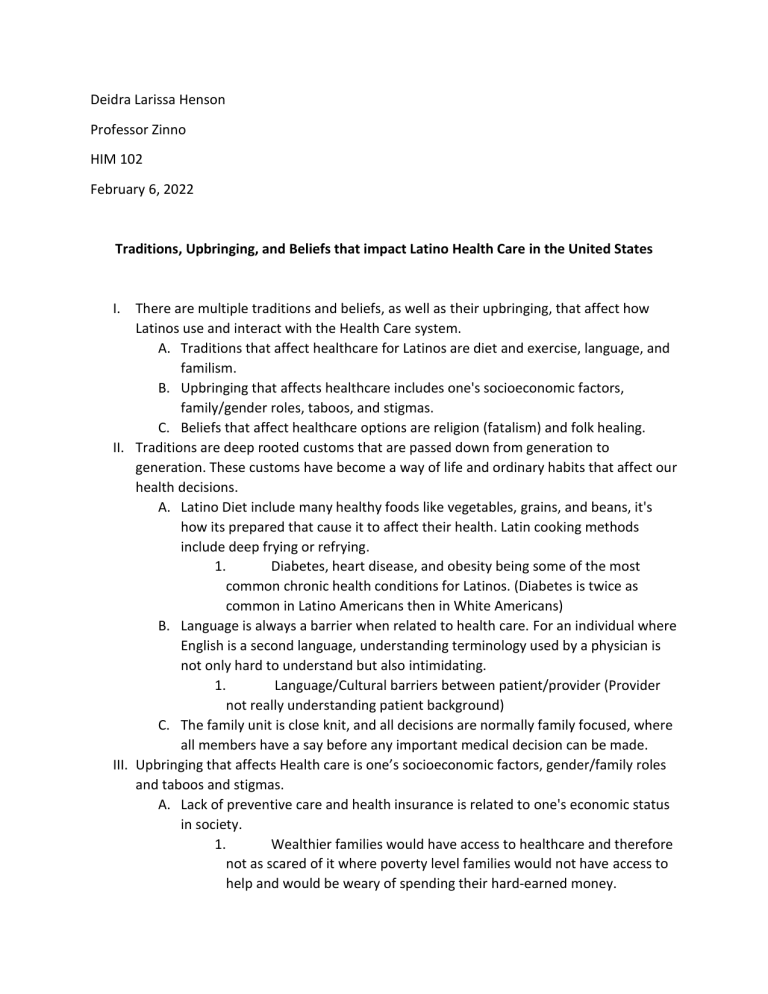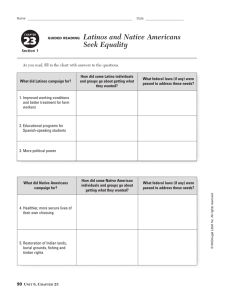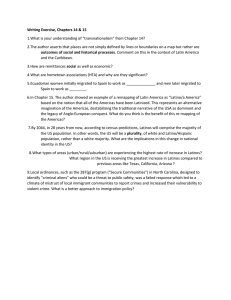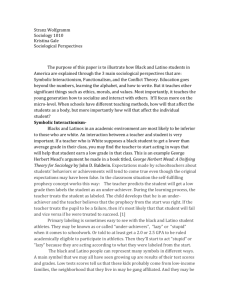
Deidra Larissa Henson Professor Zinno HIM 102 February 6, 2022 Traditions, Upbringing, and Beliefs that impact Latino Health Care in the United States I. There are multiple traditions and beliefs, as well as their upbringing, that affect how Latinos use and interact with the Health Care system. A. Traditions that affect healthcare for Latinos are diet and exercise, language, and familism. B. Upbringing that affects healthcare includes one's socioeconomic factors, family/gender roles, taboos, and stigmas. C. Beliefs that affect healthcare options are religion (fatalism) and folk healing. II. Traditions are deep rooted customs that are passed down from generation to generation. These customs have become a way of life and ordinary habits that affect our health decisions. A. Latino Diet include many healthy foods like vegetables, grains, and beans, it's how its prepared that cause it to affect their health. Latin cooking methods include deep frying or refrying. 1. Diabetes, heart disease, and obesity being some of the most common chronic health conditions for Latinos. (Diabetes is twice as common in Latino Americans then in White Americans) B. Language is always a barrier when related to health care. For an individual where English is a second language, understanding terminology used by a physician is not only hard to understand but also intimidating. 1. Language/Cultural barriers between patient/provider (Provider not really understanding patient background) C. The family unit is close knit, and all decisions are normally family focused, where all members have a say before any important medical decision can be made. III. Upbringing that affects Health care is one’s socioeconomic factors, gender/family roles and taboos and stigmas. A. Lack of preventive care and health insurance is related to one's economic status in society. 1. Wealthier families would have access to healthcare and therefore not as scared of it where poverty level families would not have access to help and would be weary of spending their hard-earned money. B. Gender/Family roles are important and play a role in all aspects of the family unit. The man is the provider/protector and usually the decision-makers, held in profound respect at an authoritative figure. Women are seen more as the dedicated mother and wife who oversees t the daily home’s coming and going, as well as the rearing of children. 1. Sex, age, social and economic status determines authority and respect. More Authority means a bigger say in what decisions are made for a person (The eldest son would have a greater say in decision if father was on a ventilator and the time came to either continue or pull plug) C. Taboos and stigmas are engrained in children at an early age 1. The primary one being that intimate and personal information is to be kept between one's partner and self. 2. Mental Illness is a sign of weakness 3. Abortion and birth control are looked down upon due to religious beliefs. IV. Beliefs that affect healthcare options are religion and folk healing. A. Most Latinos are Catholic and believe that through faith, prayers, and the church, all illnesses can be healed. And if one is sick, there is a spiritual explanation (it was God’s will) and way to heal is through the church (baptisms, last rites). B. Folk Healings are a non-convention care option where a healer used herbal remedies to treat patients. There is cultural distrust in non-natural medicine. V. There are many deep-rooted aspects of Latino Culture that pave the way to poor medical understanding and utilization. Education of both the cultural aspects for the provider and generic medical understanding for the patient would help ease Latino families into seeing professionals for health concerns. CITATIONS: Johnson, M. J., & Farquharson, H. R. (2019, December). Hispanic culture and healthcare in the United States: One Person's perspective. Retrieved February 6, 2022, from https://www.pulsus.com/scholarly-articles/hispanic-culture-and-healthcare-in-theunited-states-one-persons-perspective.pdf Latino Culture & Health. Arizona State University. (n.d.). Retrieved February 6, 2022, from https://www.public.asu.edu/~cbaldwi1/swborderlands/lch.htm Machado, A. (2014, May 7). Why many latinos dread going to the doctor. The Atlantic. Retrieved February 6, 2022, from https://www.theatlantic.com/health/archive/2014/05/why-many-latinos-dread-going-tothe-doctor/361547/ Rivera, D. G. M. (2016). COA. Retrieved February 6, 2022, from https://www.coa.org/2016/presentations/qme/7HispanicPatient101kkk.pdf US Department of Health and Human Services. (2021, October 12). Office of Minority Health. Hispanic/Latino - The Office of Minority Health. Retrieved February 6, 2022, from https://minorityhealth.hhs.gov/omh/browse.aspx?lvl=3&lvlid=64#:~:text=Some%20other %20health%20conditions%20and,are%20disparities%20among%20Hispanic%20subgroup s. Velasco-Mondragon, E., Jimenez, A., Palladino-Davis, A. G., Davis, D., & Escamilla-Cejudo, J. A. (2016, December 7). Hispanic Health in the USA: A scoping review of the literature - public health reviews. BioMed Central. Retrieved February 6, 2022, from https://publichealthreviews.biomedcentral.com/articles/10.1186/s40985-016-0043-2
![The Power of NOW[3741]](http://s2.studylib.net/store/data/025690828_1-687eebfb243c6979cdc2ac319fc077fd-300x300.png)





